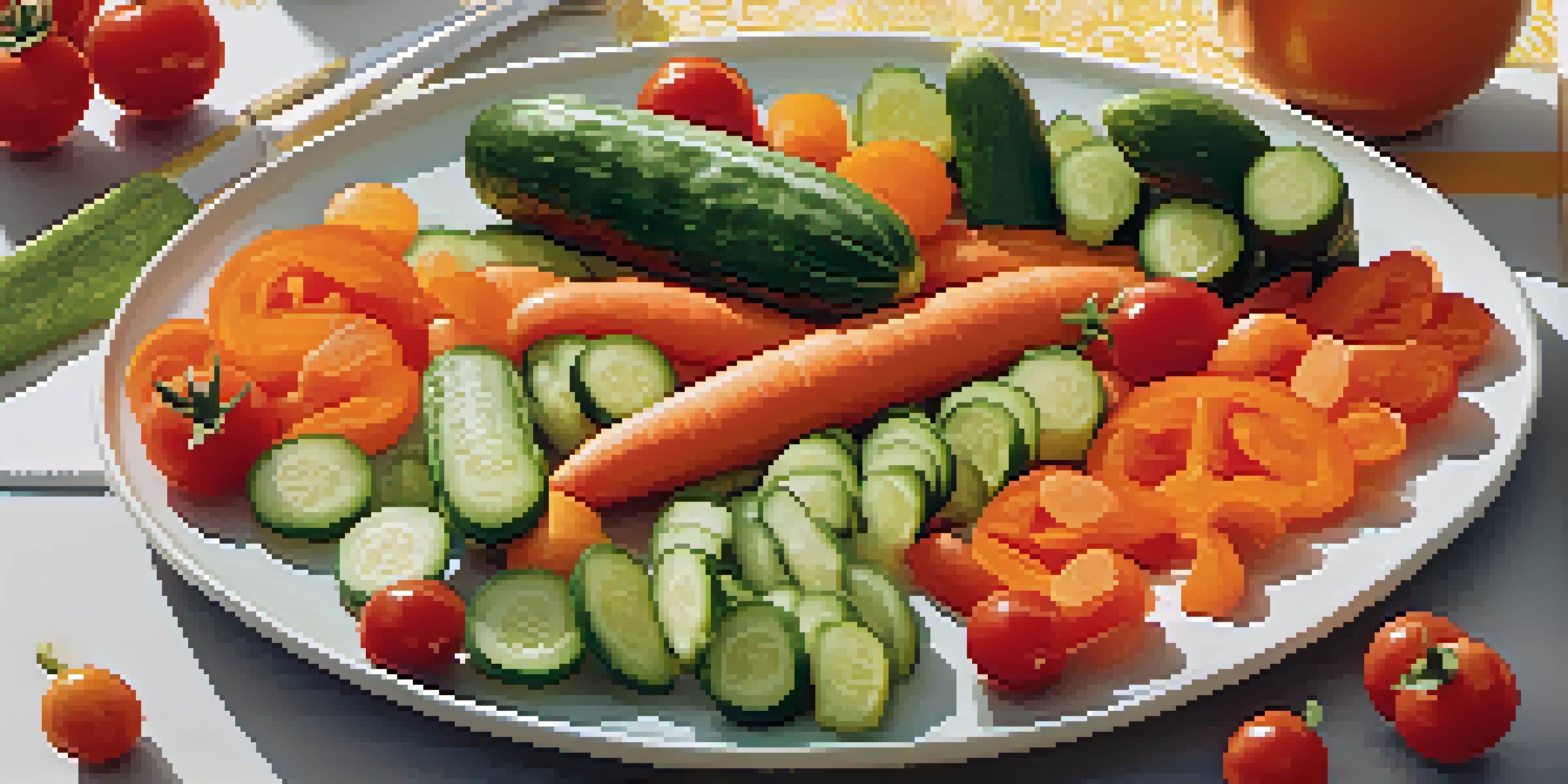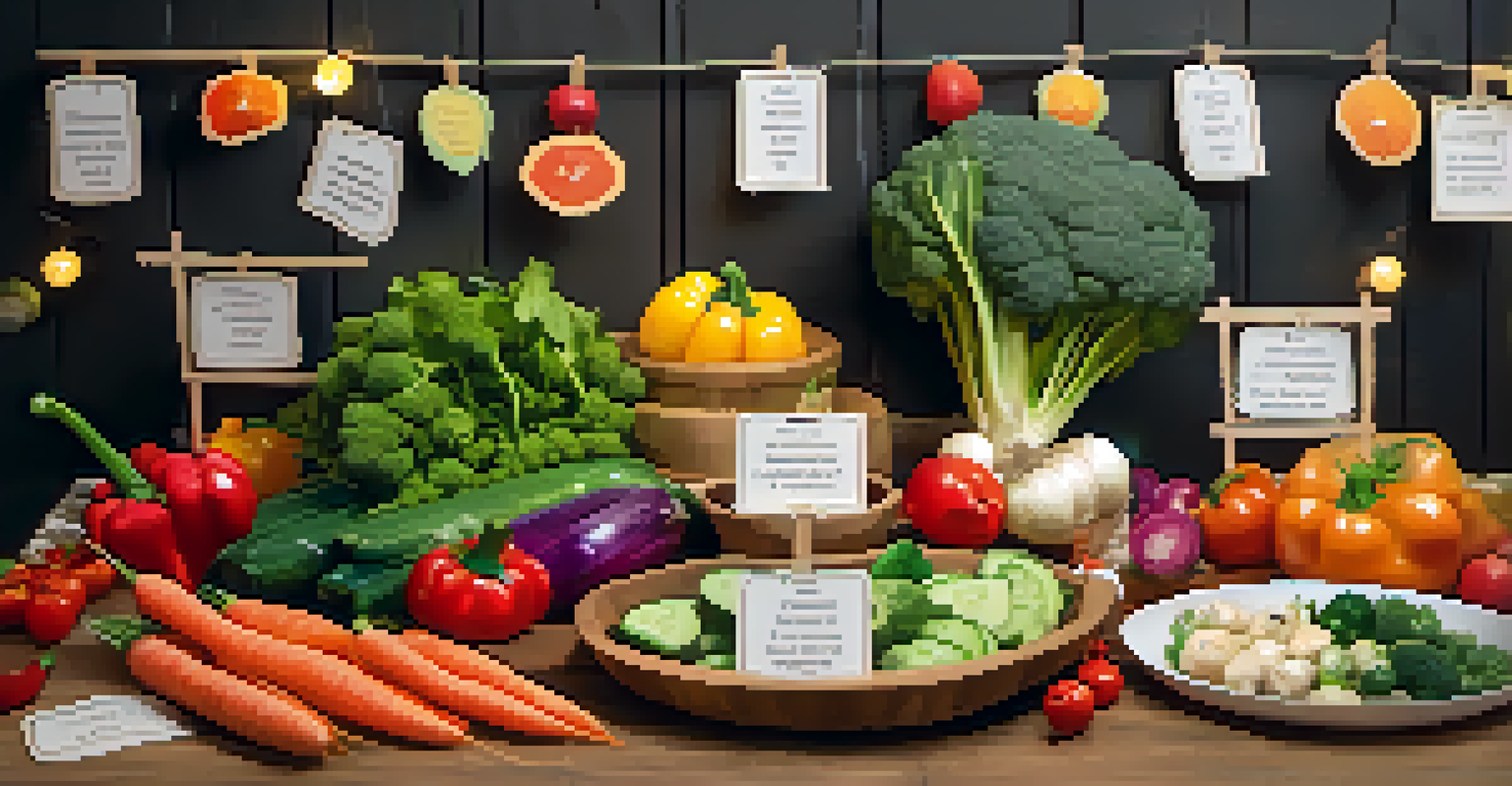Creative Ways to Introduce Vegetables to Children

Transform Veggies into Fun Shapes and Characters
Kids are naturally drawn to playful things, so why not make veggies fun? Use cookie cutters to create star-shaped cucumbers or animal-shaped carrots. This simple trick can turn a mundane vegetable into an exciting snack.
Eating vegetables is a celebration of life, a celebration of health, and a celebration of the earth.
You can also create veggie characters by arranging colorful vegetables on a plate. For instance, use cherry tomatoes for eyes and a bell pepper slice for a mouth to make a silly face. This visual appeal can spark curiosity and encourage kids to try new flavors.
Engaging kids in the kitchen can enhance their interest in vegetables. Invite them to help with the process—let them choose shapes, arrange the veggies, or even create their own character designs. This can foster a sense of ownership and excitement around eating healthy.
Involve Kids in Growing Their Own Vegetables
There's something magical about watching a seed transform into a plant. Consider starting a small garden at home or using pots if space is limited. Kids will be more likely to eat what they've grown themselves!

Involve children in the entire process, from planting seeds to watering the plants. This hands-on experience can instill a sense of responsibility and pride, making them more inclined to taste the fruits of their labor.
Make Veggies Fun and Engaging
Using playful shapes and colors can spark kids' interest in vegetables.
Even if you don’t have a garden, many vegetables can be grown indoors or in small spaces. Herbs, lettuce, and radishes are great options. Taking care of these plants can be a bonding experience and a lesson about healthy eating.
Create Colorful Veggie Dips for Extra Fun
Dips can make vegetables more appealing, especially for kids who might be hesitant to eat them plain. Try creating colorful dips, like a bright green avocado or a vibrant red hummus, to make the experience more inviting.
You don’t have to cook fancy or complicated masterpieces—just good food from fresh ingredients.
You can involve your kids in the dipping process, allowing them to pick their favorite vegetables to pair with their chosen dip. This not only makes eating veggies more interactive but also gives them a sense of control over their food choices.
Experiment with different flavors and ingredients to find dips that your kids love. The more options you provide, the more likely they are to discover new tastes and develop a fondness for vegetables.
Incorporate Veggies into Favorite Family Recipes
One of the easiest ways to introduce vegetables is by sneaking them into beloved meals. For instance, adding finely chopped spinach or zucchini to pasta sauce can boost nutrition without changing the dish too much.
Encourage your kids to help with these recipes. Let them add veggies to the mix, so they feel involved in the cooking process. They might just surprise you by enjoying the meals they helped create!
Involve Kids in Growing and Cooking
Engaging children in gardening and cooking fosters a sense of ownership and excitement about eating healthy.
You can also substitute traditional ingredients with healthier options, like using cauliflower rice instead of white rice. This way, children can enjoy their favorite foods while getting the benefits of more vegetables.
Make Veggie-Inspired Smoothies Together
Smoothies are a fantastic way to pack in nutrients without overwhelming kids with the taste of vegetables. Blend fruits with a handful of spinach or kale to create delicious, vibrant drinks that kids will love.
Let the kids pick their favorite fruits to include, which can make them more excited about trying the greens. The colorful outcome can be visually appealing, making it an enticing treat.
As they sip on their creations, talk about the benefits of the ingredients. This can help demystify vegetables and show kids that healthy choices can also be delicious.
Host a Family Veggie Tasting Night
Make eating vegetables an event by hosting a family tasting night! Set out a variety of colorful vegetables and let everyone sample each one. This interactive experience can make veggies feel less intimidating.
Encourage kids to share their thoughts on each vegetable. They might discover they love something they previously avoided. You can even create a fun rating system to see which ones are favorites!
Create Interactive Tasting Experiences
Hosting tasting nights and using storytelling can make trying new vegetables a fun family activity.
This tasting night can help cultivate a sense of adventure with food. It’s a great opportunity for families to bond over trying new things and discussing flavors and textures together.
Use Storytelling to Highlight Veggie Benefits
Kids love stories, so why not use them to introduce vegetables? Create fun narratives around different veggies, perhaps featuring a superhero carrot saving the day or broccoli as a brave knight.
You can tie these stories into mealtime by asking kids to choose their favorite 'character' to eat. This imaginative approach can make eating vegetables feel like part of a grand adventure.

By connecting vegetables to their favorite stories, kids can develop a positive association with healthy eating, making them more likely to reach for veggies in the future.
Lead by Example: Show Your Love for Veggies
Kids often mirror adult behaviors, so it's crucial to demonstrate your love for vegetables. Make it a point to include a variety of veggies in your meals and snacks, showing them how enjoyable it can be.
Share your excitement about trying new vegetables or experimenting with different recipes. This enthusiasm can be contagious and encourage children to adopt a similar mindset.
Discuss the benefits of eating vegetables openly, making it a part of your daily conversations. When kids see their parents valuing healthy eating, they’re more likely to adopt those habits themselves.